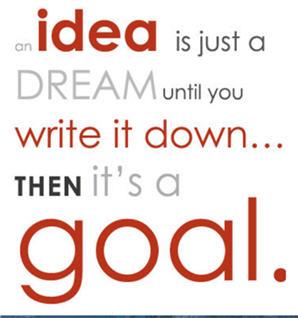
Creating Goals Is a “Wealthy” Habit (Refer back to part 1 for “Wealthy” vs. “Poor” habits.)
Goals are specific, measurable tasks or activities in which you, (individual/family), will engage. There is no limit to the number of goals you may or should set. There should be a combination of both long-term and short-term goals. Goals should address both needs and wants. Ideally, each goal will have two or three alternative ways of achieving it.
You should create goals just like businesses do. Schedule a time for everyone in the family to meet together in a setting that is not subject to interruptions. Devices should all be turned off. Explain to children that you are going to ask them to think of something they would like to have, do, or be. This will be a “goal” for them to achieve. Tell them that the goal they set will probably not happen immediately. It is something they will have to work towards.
No goal is too insignificant not only because it is important to someone, but because most goals have a price tag attached. Goals can be for one or more individuals or for the entire family.
It is important that all members of the family provide input into the setting of goals. It is even more important that each member of the family agrees to help meet the family’s goals especially when the goals are used to determine how money will be spent.
Answer the following questions:
- How do you decide how your money will be spent?
- Do you have a plan or are all expenditures spontaneous?
- Are you sometimes torn between spending money on things you really want versus things you need?
- Are you trying to stretch dollars to the point of breaking?
- Has deciding how you will spend money become a tug-a-war?
- Do you use a credit card to purchase basic food, pay utility bills, or purchase basic transportation items (i.e. gas or bus pass) because you do not have sufficient funds in your bank account to pay cash for these items? (Use of a debit card is the same as using cash.)
- Have you been charged overdraft fees during the past six months due to insufficient funds in your bank account to cover debit card use and checks written?
The answers to these questions can provide early warning signs of financial distress. The last two questions are especially important early warning signs of debt. When debt instruments, such as a credit card, are used to purchase basic needs because you do not have enough cash with which to purchase those items, you need to ask yourself a very difficult question each time you make any purchase: “Is this item I am purchasing a need or a want?” Regardless of the answer, you then must ask another difficult question before any purchase, “How does this purchase support our goals?”
GOAL BASED BUDGETING
GOAL BASED BUDGETING is the process of creating a budget based upon the goals that you have set for yourself. The success of GOAL BASED BUDGETING hinges strongly on your dedication to the task. Done correctly, it is a time consuming process, but it is one of the best ways to ensure against unnecessary spending.
The development and implementation of the GOAL BASED BUDGETING model requires you to engage in several major planning, analytic and decision-making processes. The major processes of GOAL BASED BUDGETING are:
- Development of your goals
- Creating a list of your needs and wants
- Needs and wants analysis
- Ranking your needs and wants
- Resource identification
- Resource allocation
- Budget preparation
- Monitoring and evaluation
Developing Your Goals
What do you want to accomplish, do, or be?
When do you want to mark it as “done”?
These are the first two steps in developing your goals. The “what” and the “when” need to be as specific as possible. For example, your goal may be to publish a book by the end of this calendar year.
This goal does meet the “what” and the “when”, but is it so broad that you could easily feel overwhelmed. To make life easier on yourself, it is best if you break the goal down into more manageable segments. Continuing our example, in order to publish a book by the end of this calendar year, you are going to write one chapter every week starting this week and continuing for the next x number of weeks, i.e. 15.
These sub-goals may still be too broad. You may want to break down the goals to another level. For example, you may say, I am going to spend one hour a day writing my chapter. Alternately, you may say, I am going to spend every Sunday from 1 – 6pm writing my chapter.
Further development of your goal to publish a book by the end of this calendar year requires putting all of the sub-goals together in a timeline to make sure you haven’t missed any mission critical tasks. Here is an example assuming you’re going start pursuing your goal in February.
|
FEB |
MAR |
APR |
MAY |
JUN |
JUL |
AUG |
SEP |
OCT |
NOV |
DEC |
|
Write Chpts 1 - 4 |
Write Chpts 5 - 9 |
Write Chpts 10 - 14 |
Write Chpts 15 - 20 |
Send to editor Revise as needed |
Cover Design
Finalize book format |
Obtain Editorial & book reviews from 10 sources |
Publisher Approval |
Finalize Ads
Detail Launch plans |
Pre- Publish Market- ing |
Publish And Launch |
Using visuals such as a timeline can help you determine whether or not you have set a realistically achievable goal.
Stay tuned for Part 3